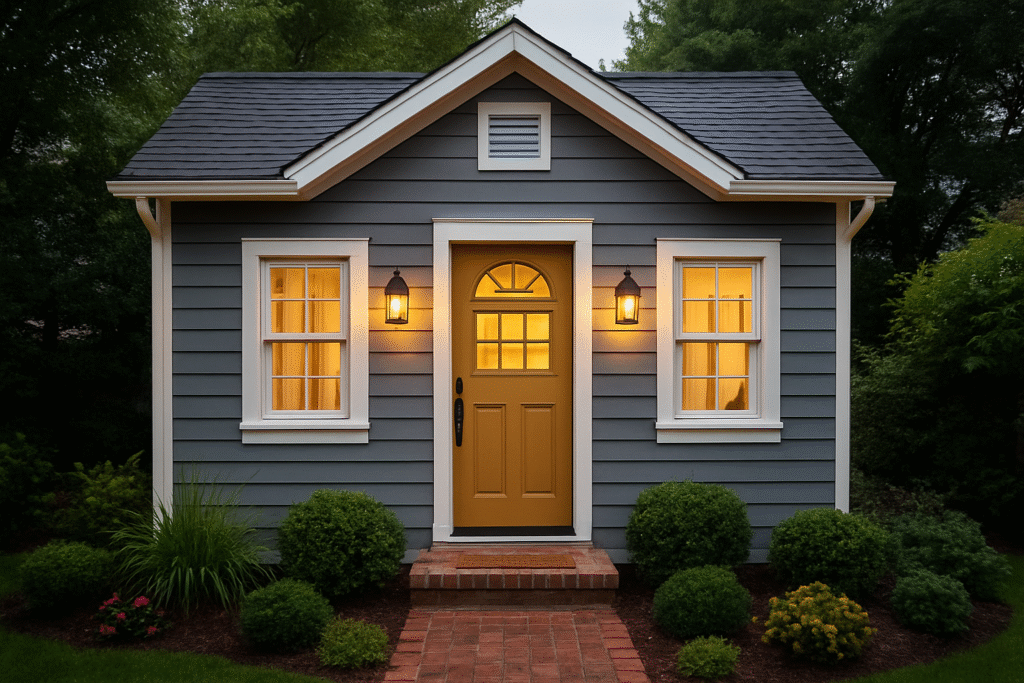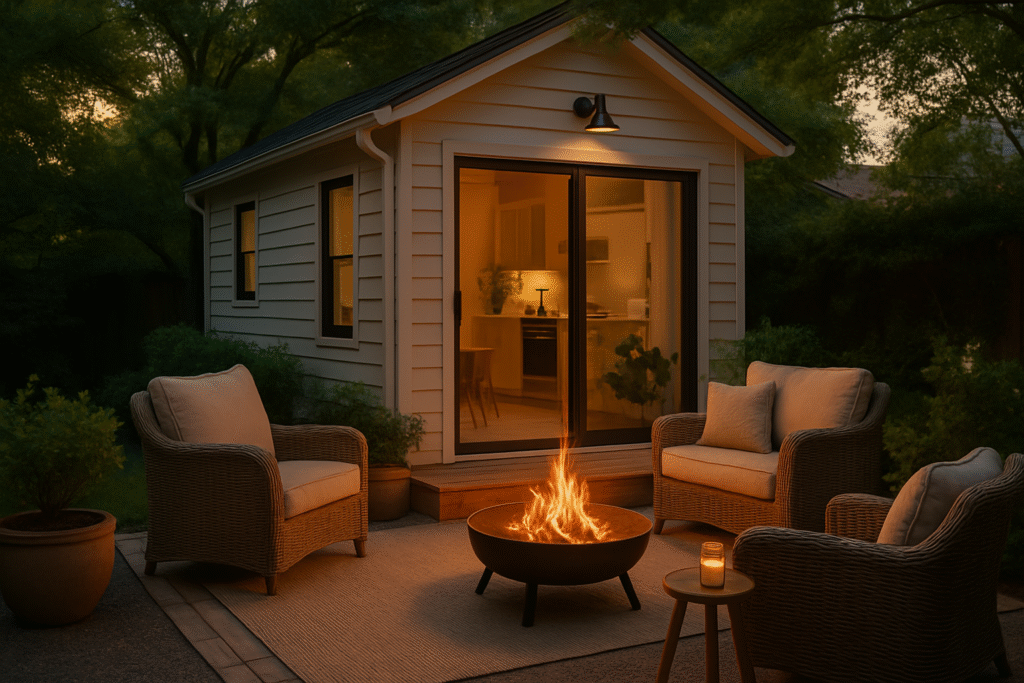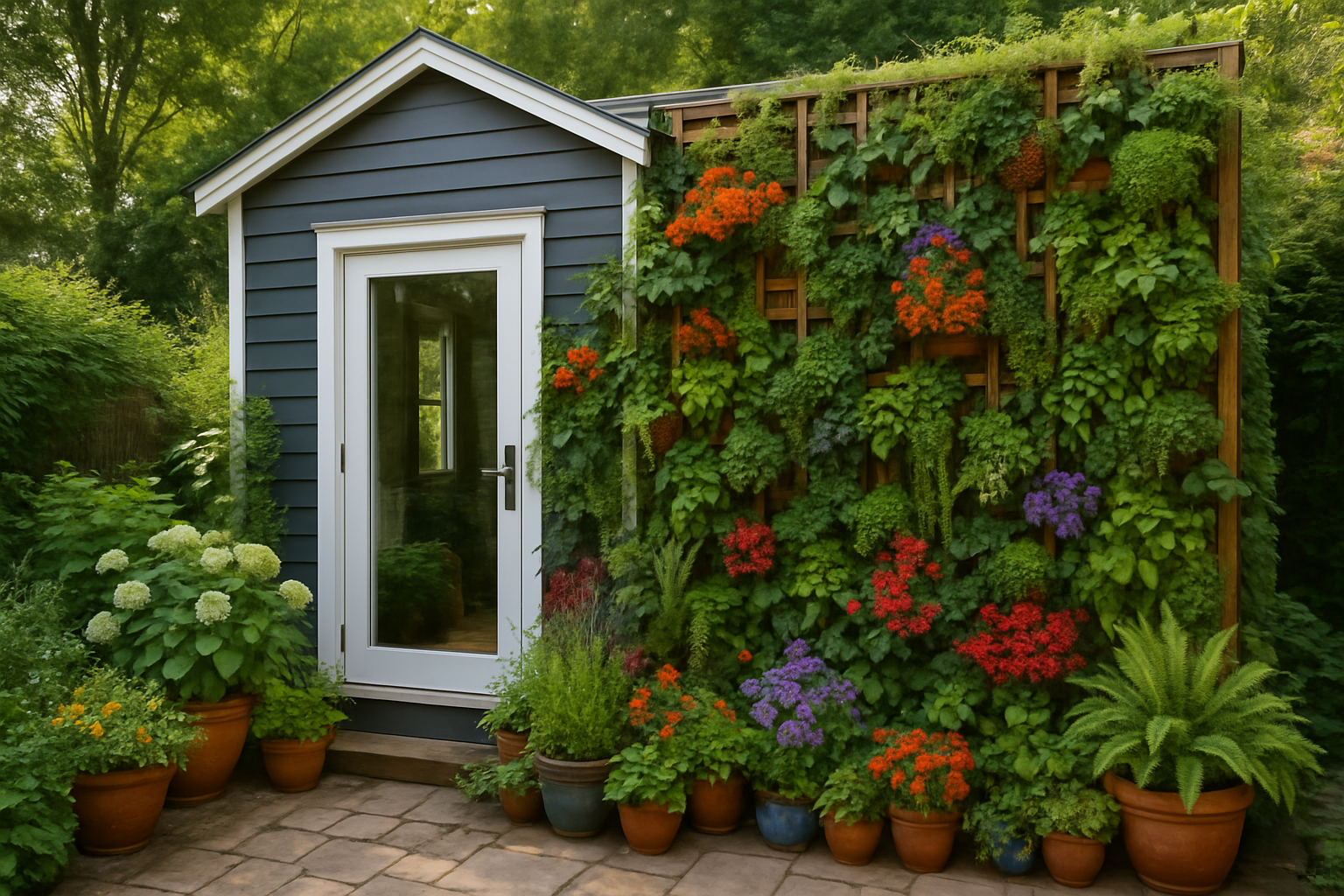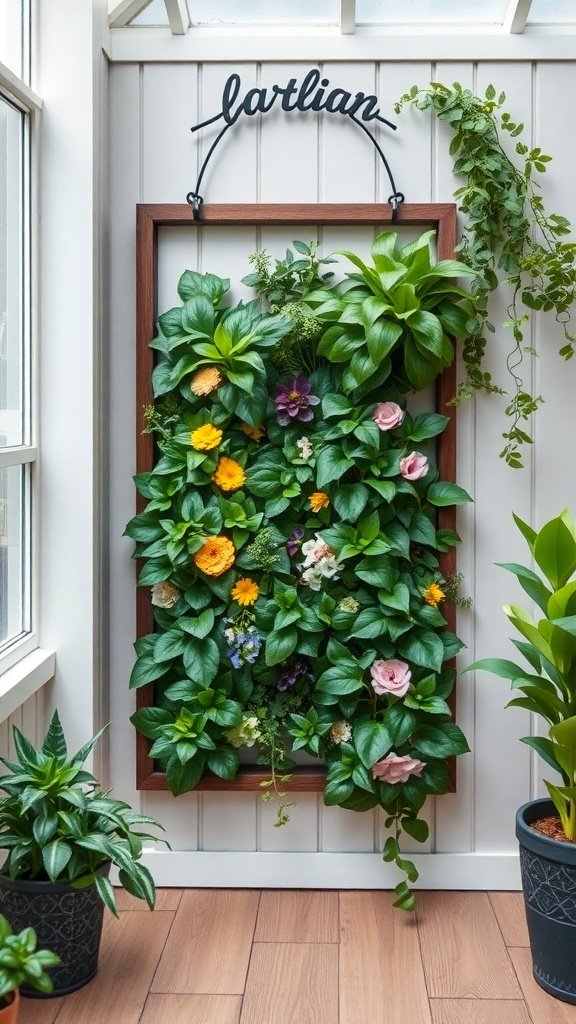In the world of tiny living, where every square foot inside is meticulously planned, it’s easy to overlook the immense potential of the space just beyond the walls. Yet, the exterior of a tiny home and its surrounding landscape are not merely aesthetic additions; they are integral extensions of the living space, offering opportunities for expanded functionality, enhanced curb appeal, and a deeper connection to nature. For tiny home dwellers, the outdoors isn’t just a view; it’s an essential part of their lifestyle, providing areas for relaxation, entertainment, and even sustenance. Embracing Landscaping and Exterior Ideas for Tiny Homes can elevate this experience significantly.
Incorporating Landscaping and Exterior Ideas for Tiny Homes can transform your outdoor space into a beautiful and functional area.
Table of Contents
For those interested in hands-on projects to enhance their tiny home, our article on DIY Tiny House Projects: Personalize Your Small Space on a Budget offers a wealth of ideas. From maximizing small plots with clever garden designs to enhancing curb appeal with thoughtful exterior finishes, and creating inviting outdoor living areas, we’ll cover everything you need to know to make your tiny home’s exterior as comfortable and captivating as its interior. Whether your tiny home is stationary or on wheels, these strategies will help you cultivate a harmonious balance between your indoor sanctuary and the natural world.
The Importance of Exterior Design in Tiny Living
While the interior of a tiny home often takes center stage in discussions about efficient living, for more on optimizing your tiny home’s interior, explore our article on Tiny House Interior Design Trends 2025: Style Meets Functionality. The exterior plays an equally crucial role in defining the overall experience.
Landscaping and Exterior Ideas for Tiny Homes are essential to maximize outdoor enjoyment.
Consider various Landscaping and Exterior Ideas for Tiny Homes to enhance the overall appeal.
Implementing Landscaping and Exterior Ideas for Tiny Homes can significantly boost property value.
Explore innovative Landscaping and Exterior Ideas for Tiny Homes to create a seamless indoor-outdoor connection.
By adopting sustainable Landscaping and Exterior Ideas for Tiny Homes, you can enhance your ecological footprint.
Integrate Landscaping and Exterior Ideas for Tiny Homes to ensure long-lasting durability.
Understanding Landscaping and Exterior Ideas for Tiny Homes is crucial for maximizing your outdoor space.
Extending Living Space: One of the most compelling reasons to invest in exterior design is the ability to effectively extend your living area. A well-designed deck, patio, or even a simple gravel pad can become an outdoor living room, dining area, or workspace. This expansion is invaluable in a tiny home, providing much-needed breathing room and diversifying the available spaces for various activities. Imagine enjoying your morning coffee on a cozy porch, hosting a small gathering under the stars, or working amidst the fresh air – these experiences are made possible by intentionally designed outdoor spaces.
Enhancing Curb Appeal and Value: The exterior of your tiny home is its public face. A well-maintained and aesthetically pleasing exterior significantly enhances its curb appeal, making it more inviting and visually appealing. This is particularly important if you ever plan to sell your tiny home or if it’s part of a tiny home community where visual harmony is valued. Thoughtful landscaping, a fresh coat of paint, or unique architectural details can dramatically increase the perceived value and desirability of your tiny dwelling. It transforms a simple structure into a charming and memorable abode.
Connecting with Nature: For many, tiny living is about simplifying life and reconnecting with nature. Exterior design facilitates this connection by blurring the lines between indoor and outdoor environments. Large windows, strategically placed planters, and accessible outdoor areas allow residents to immerse themselves in their surroundings. This biophilic design approach has proven benefits for mental well-being, reducing stress and fostering a sense of calm. Even in urban settings, a small garden or a thoughtfully designed patio can provide a much-needed green escape.
Utilizing Landscaping and Exterior Ideas for Tiny Homes can significantly improve outdoor usability.
Sustainability and Environmental Integration: The exterior of a tiny home offers numerous opportunities for sustainable practices. Rainwater harvesting systems can be integrated into roof designs, providing a sustainable water source for landscaping or even indoor use. Strategic planting can offer natural shading in summer and windbreaks in winter, reducing energy consumption for heating and cooling. Permaculture principles can be applied to create edible landscapes, providing fresh produce and reducing reliance on external food sources. For more information on permaculture, you can visit Permaculture Research Institute. These integrations not only benefit the environment but also contribute to the self-sufficiency and resilience of the tiny home.
Landscaping and Exterior Ideas for Tiny Homes should align with your lifestyle and aesthetic preferences.
Protection and Durability: Beyond aesthetics, the exterior design is crucial for protecting your tiny home from the elements. Proper siding, roofing, and foundation design are essential for durability and longevity. Landscaping can also play a protective role, directing water away from the foundation, preventing erosion, and providing insulation. Choosing durable, weather-resistant materials for the exterior ensures that your tiny home remains a safe and secure haven for years to come.
Landscaping and Exterior Ideas for Tiny Homes can create a vibrant and productive outdoor environment.

Section 1: Maximizing Small Plots: Clever Garden Designs for Tiny Homes
Consider integrating features from Landscaping and Exterior Ideas for Tiny Homes into your design.
Landscaping and Exterior Ideas for Tiny Homes can blend functionality and beauty.
Adopting Landscaping and Exterior Ideas for Tiny Homes fosters community and connection.
Innovative Landscaping and Exterior Ideas for Tiny Homes can redefine small space living.
Landscaping and Exterior Ideas for Tiny Homes will enhance your outdoor experience.
Even the smallest plot of land around a tiny home can be transformed into a lush and productive garden. The key is to think creatively and utilize every available space, from vertical surfaces to portable containers. These clever garden designs not only add beauty but can also provide fresh produce and a sense of connection to the earth.
Explore the versatility of Landscaping and Exterior Ideas for Tiny Homes in your outdoor planning.
Vertical Gardens: When horizontal space is limited, go vertical! Vertical gardens are an ingenious solution for tiny homes, allowing you to grow a variety of plants on walls, fences, or even the side of your tiny house. Options include:
•Pallet Gardens: Repurpose old wooden pallets into multi-tiered planters. They are inexpensive, easy to construct, and can hold herbs, small vegetables, or flowers.
•Pocket Planters: Fabric pocket planters can be hung on any vertical surface, providing individual pockets for various plants. They are lightweight and flexible, making them ideal for tiny homes.
•Trellises and Arbors: Use trellises for climbing plants like cucumbers, beans, or flowering vines. An arbor can create a beautiful entryway while supporting edible or ornamental plants.
Container Gardening: Containers offer unparalleled flexibility for tiny home gardens, especially for those on wheels. You can move plants to optimize sunlight, protect them from harsh weather, or rearrange your outdoor space as needed. Consider:
•Smart Pots: Fabric pots that promote air pruning, leading to healthier root systems and better plant growth.
•Self-Watering Planters: Ideal for busy tiny home dwellers, these planters have a reservoir that provides a consistent water supply to plants.
•Tiered Planters: Maximize vertical space by stacking multiple planters, perfect for herbs or small vegetables.
Edible Landscaping: Integrate edible plants into your ornamental landscaping. Berry bushes can serve as attractive hedges, while fruit trees can provide shade and a harvest. Herbs can be planted along pathways, releasing fragrant aromas as you walk by. This approach makes your garden both beautiful and productive, contributing to food self-sufficiency.
Raised Garden Beds: Raised beds offer several advantages for tiny home gardens. They provide better drainage, allow for easier access (reducing bending), and can be filled with nutrient-rich soil. They also create a defined aesthetic boundary for your garden space. You can build them from reclaimed wood, corrugated metal, or even stone, matching the style of your tiny home.
Miniature Greenhouses and Cold Frames: Extend your growing season and protect delicate plants with a miniature greenhouse or cold frame. These can be small, portable structures that fit neatly beside your tiny home, allowing you to start seedlings earlier or grow cool-season crops later into the year. Some designs are even collapsible for easy storage when not in use.
Section 2: Enhancing Curb Appeal: Thoughtful Exterior Finishes and Details
The exterior of your tiny home is its public statement, and thoughtful design choices can significantly enhance its curb appeal, making it a welcoming and attractive space. Beyond structural integrity, the finishes and details you choose can reflect your personal style and create a lasting impression. This section explores how to elevate your tiny home’s exterior from functional to fabulous.
Siding Materials: The choice of siding material is paramount, influencing both aesthetics and durability. Consider materials that are not only visually appealing but also weather-resistant and low-maintenance:
•Wood Siding: Classic and versatile, wood siding (cedar, pine, redwood) offers a natural, warm aesthetic. It can be stained or painted to match any design vision. Regular maintenance is required to protect against the elements.
•Metal Siding: Durable, low-maintenance, and fire-resistant, metal siding (corrugated steel, standing seam) provides a modern, industrial look. It’s an excellent choice for contemporary tiny homes and can come in various colors.
•Fiber Cement Siding: A blend of wood pulp, cement, and sand, fiber cement siding (e.g., HardiePlank) is highly durable, resistant to rot, pests, and fire, and can mimic the look of wood or stucco. It’s a long-lasting, low-maintenance option.
•Vinyl Siding: An affordable and low-maintenance option, vinyl siding comes in a wide range of colors and styles. While less durable than other options, it offers good protection against moisture.
Roofing Materials: The roof is a significant visual element and crucial for protection. Consider materials that complement your home’s style and offer longevity:
•Metal Roofing: Popular for tiny homes due to its durability, longevity, and lightweight nature. It’s also energy-efficient, reflecting solar radiation. Available in various profiles and colors.
•Asphalt Shingles: A cost-effective and widely available option, asphalt shingles are easy to install and repair. They come in many colors and styles to match different aesthetics.
•Living Roofs (Green Roofs): For stationary tiny homes, a living roof can provide insulation, manage stormwater, and add a unique aesthetic. It involves growing vegetation on the roof, contributing to biodiversity and sustainability.
Window and Door Selection: Windows and doors are not just entry points; they are key design features that impact natural light, ventilation, and curb appeal. Consider:
•Large Windows: Maximize natural light and views with large windows, especially in living areas. This creates a sense of openness and connects the interior with the exterior.
•French Doors or Sliding Glass Doors: These can seamlessly connect indoor and outdoor living spaces, making the tiny home feel larger and more integrated with its surroundings.
•Unique Entry Doors: A brightly colored or uniquely designed front door can add a pop of personality and serve as a welcoming focal point. Consider incorporating a small overhang or awning for added charm and protection.
Exterior Lighting: Thoughtful exterior lighting enhances safety, functionality, and ambiance. Consider:
•Pathway Lighting: Illuminates walkways, ensuring safe passage after dark.
•Accent Lighting: Highlights architectural features, landscaping, or outdoor art.
•Porch Lights: Provides illumination for entryways and creates a welcoming glow.
Color Palette: The exterior color scheme sets the tone for your tiny home. Consider:
•Harmonious with Surroundings: Choose colors that blend well with the natural environment or complement the architectural style of nearby structures.
•Pops of Color: Use a vibrant front door, window trim, or planters to add personality and visual interest without overwhelming the small facade.
•Light Colors for Small Spaces: Lighter colors can make a tiny home appear larger and more expansive, reflecting light and creating a sense of openness.

Section 3: Creating Inviting Outdoor Living Areas
For tiny home dwellers, the outdoor space often serves as an extension of the interior, providing crucial areas for relaxation, dining, and entertaining. Designing these outdoor living areas requires creativity and strategic planning to maximize comfort and functionality within a limited footprint. The goal is to create inviting zones that enhance the overall living experience.
Decks and Patios: A well-designed deck or patio can significantly expand your usable living space. Consider:
•Multi-Level Decks: If your tiny home is on a sloped lot, multi-level decks can create distinct zones for dining, lounging, or gardening, adding visual interest and functionality.
•Fold-Down Decks: For tiny homes on wheels, a fold-down deck can be a game-changer, providing an instant outdoor platform that can be easily stowed for travel. These often integrate seamlessly with the home’s exterior when folded.
•Paved Patios: Gravel, pavers, or flagstones can create a charming and low-maintenance patio area. These materials offer a stable surface for outdoor furniture and can be designed in various patterns to complement your home’s aesthetic.
Outdoor Furniture: Choose furniture that is proportionate to the space and ideally multi-functional. Consider:
•Foldable or Stackable Furniture: Chairs and tables that can be easily folded or stacked away when not in use are ideal for maximizing flexibility in small outdoor areas.
•Built-In Seating with Storage: Benches with hidden storage compartments can provide both seating and valuable storage for outdoor cushions, gardening tools, or recreational equipment.
•Hammocks or Swing Chairs: These can add a touch of whimsy and comfort, providing a relaxing spot without taking up much floor space when not in use.
Outdoor Kitchens and Dining Areas: Even a small outdoor space can accommodate a functional cooking and dining area. Consider:
•Portable Grills or Pizza Ovens: These allow for outdoor cooking without the need for a permanent structure.
•Fold-Out Tables: A wall-mounted fold-out table can provide a convenient dining surface that disappears when not needed.
•Herb Gardens Near the Kitchen: Plant herbs and small vegetables in containers near your outdoor cooking area for easy access to fresh ingredients.
Privacy Solutions: Creating a sense of privacy is essential for comfortable outdoor living. Consider:
•Privacy Screens: Lattice panels, bamboo screens, or decorative metal screens can provide instant privacy without feeling imposing.
•Strategic Planting: Tall shrubs, climbing vines on a trellis, or dense hedges can create natural privacy barriers.
•Pergolas or Awnings: These structures can provide shade and a sense of enclosure, making your outdoor space feel more intimate.
Implementing Landscaping and Exterior Ideas for Tiny Homes helps create a vibrant atmosphere.
Fire Pits and Outdoor Heating: Extend the usability of your outdoor space into cooler evenings with a fire pit or outdoor heater. Consider:
•Portable Fire Pits: Easy to move and store, these are perfect for occasional use.
•Propane Heaters: Provide instant warmth and are convenient for quick use.
Implementing Landscaping and Exterior Ideas for Tiny Homes can be a rewarding experience.
•Built-In Fire Pits: For stationary tiny homes, a built-in fire pit can be a beautiful focal point and gathering spot.
Section 4: Sustainable Landscaping Practices for Tiny Homes
Embracing sustainable landscaping practices is a natural extension of the tiny living philosophy. These approaches not only minimize environmental impact but also create resilient, low-maintenance, and beautiful outdoor spaces. For tiny home dwellers, sustainable landscaping is about working with nature, not against it, to create a harmonious and eco-conscious environment.
Native Plantings: Choosing native plants is one of the most impactful sustainable landscaping decisions. Native plants are naturally adapted to your local climate and soil conditions, requiring less water, fertilizer, and pest control. They also support local ecosystems by providing food and habitat for native wildlife, such as birds and pollinators. Research your local native plant nurseries and select species that thrive in your region.
Water Conservation: Water is a precious resource, and tiny home landscaping offers many opportunities for conservation:
•Rainwater Harvesting: Install a rainwater harvesting system to collect water from your roof for irrigation. This reduces reliance on municipal water supplies and can significantly lower your water bill. Simple rain barrels are a great starting point.
•Drought-Tolerant Plants (Xeriscaping): Select plants that require minimal water once established. Succulents, ornamental grasses, and many native species are excellent choices for xeriscaping, creating beautiful landscapes with minimal irrigation.
•Drip Irrigation: Instead of traditional sprinklers, use drip irrigation systems that deliver water directly to the plant roots, minimizing evaporation and runoff. This is highly efficient and reduces water waste.
Utilizing Landscaping and Exterior Ideas for Tiny Homes will enhance your outdoor aesthetic.
•Mulching: Apply a layer of organic mulch (wood chips, straw, compost) around your plants. Mulch helps retain soil moisture, suppresses weeds, and enriches the soil as it decomposes.
Composting: Turn your kitchen scraps and garden waste into nutrient-rich compost. A small composting bin or worm farm can be easily integrated into your tiny home’s outdoor space. Compost improves soil health, reduces the need for chemical fertilizers, and diverts waste from landfills. This closed-loop system embodies the principles of sustainability.
Permaculture Principles: Apply permaculture design principles to create a self-sustaining and productive landscape. This involves observing natural patterns and designing systems that mimic ecosystems. Examples include:
Explore unique Landscaping and Exterior Ideas for Tiny Homes to enhance curb appeal.
Landscaping and Exterior Ideas for Tiny Homes can help create a sense of community.
Incorporating Landscaping and Exterior Ideas for Tiny Homes enhances your living environment.
•Zone Planning: Arrange plants and elements based on how frequently you interact with them. High-use plants (herbs, salad greens) should be closest to the house, while less frequently accessed elements (fruit trees, compost) can be further away.
•Guilds: Plant mutually beneficial species together. For example, planting nitrogen-fixing plants near fruit trees can improve soil fertility.
Make sure to include Landscaping and Exterior Ideas for Tiny Homes in your planning.
•Water Management: Design your landscape to capture and retain water, using swales, rain gardens, or terracing to direct water to plants.
Natural Pest Control: Avoid chemical pesticides by encouraging beneficial insects and using natural pest control methods. Companion planting (e.g., marigolds to deter nematodes) and attracting predatory insects (e.g., ladybugs for aphids) can keep your garden healthy without harmful chemicals. This approach protects both your family and the environment.
Section 5: Essential Considerations for Tiny Home Exteriors
Beyond design and aesthetics, several practical considerations are crucial when planning the exterior of your tiny home. These elements ensure the longevity, safety, and functionality of your dwelling, especially given the unique challenges and opportunities of tiny living.
Climate and Weather: Your local climate should heavily influence your exterior material choices and design. In rainy climates, prioritize excellent drainage and moisture-resistant materials. In hot climates, consider light-colored roofing and siding to reflect heat, and strategic shading from trees or awnings. In cold climates, focus on superior insulation and materials that can withstand freezing temperatures and heavy snow loads. Understanding your climate will help you choose materials that perform well and reduce maintenance.
Maintenance and Durability: Opt for exterior materials that are durable and require minimal maintenance. While some natural materials like wood may require regular sealing or painting, others like metal or fiber cement siding are virtually maintenance-free. Consider the long-term costs and effort associated with upkeep when making your selections. Easy-to-clean surfaces and materials that resist fading, cracking, and warping will save you time and money in the long run.
Consider new Landscaping and Exterior Ideas for Tiny Homes to elevate your outdoor spaces.
Weight and Mobility (for Tiny Homes on Wheels): If your tiny home is on a trailer, weight is a critical factor. Every material choice, from siding to roofing, contributes to the overall weight. Exceeding the trailer’s Gross Vehicle Weight Rating (GVWR) is illegal and dangerous. Prioritize lightweight materials where possible, and carefully calculate the weight of all components. Mobility also influences design; ensure that any exterior features, like fold-down decks or awnings, can be securely stowed for travel.
Landscaping and Exterior Ideas for Tiny Homes are key to maximizing outdoor experiences.
Local Regulations and Zoning: Before embarking on any exterior or landscaping project, research local zoning laws and building codes. These regulations can dictate everything from setbacks and maximum heights to material restrictions and utility connections. Some areas may have specific requirements for tiny homes, especially regarding their classification as permanent dwellings or RVs. Compliance ensures your tiny home is legal and avoids potential fines or forced modifications.
Landscaping and Exterior Ideas for Tiny Homes focus on efficiency and beauty.
Accessibility: Consider accessibility for both residents and maintenance. Ensure pathways are clear and safe, especially in wet or icy conditions. If you plan to age in place or have mobility challenges, incorporate ramps, wider doorways, and accessible outdoor areas. Think about how you will access your roof for cleaning or maintenance, and ensure garden beds are at a comfortable height for tending.
Pest and Wildlife Management: Tiny homes can be susceptible to pests and wildlife if not properly protected. Ensure all exterior openings are sealed, and consider materials that deter insects and rodents. Landscaping choices can also play a role; avoid planting dense shrubs directly against the house, as they can provide cover for pests. Proper drainage also helps prevent moisture-loving insects.
Conclusion: Cultivating Your Tiny Outdoor Oasis
Utilizing Landscaping and Exterior Ideas for Tiny Homes can lead to better outdoor living.
Incorporate Landscaping and Exterior Ideas for Tiny Homes for a more sustainable lifestyle.
The exterior of your tiny home is far more than just a facade; it’s an integral part of your living experience, offering boundless opportunities for beauty, functionality, and connection with the natural world. By thoughtfully integrating landscaping and exterior design, tiny home dwellers can extend their living spaces, enhance curb appeal, and embrace sustainable practices that align with their minimalist values. From ingenious vertical gardens and versatile container plantings to durable siding materials and inviting outdoor living areas, every choice contributes to creating a harmonious and resilient sanctuary.
Remember to consider your climate, prioritize low-maintenance solutions, and always adhere to local regulations to ensure your outdoor oasis thrives. As the tiny house movement continues to grow, the emphasis on cultivating these exterior spaces will undoubtedly become even more pronounced, transforming compact dwellings into truly holistic and inspiring homes that celebrate both indoor comfort and outdoor serenity. Embrace the potential of your tiny home’s exterior, and watch as it blossoms into a reflection of your lifestyle and a testament to thoughtful, sustainable living.
ecosystems by providing food and habitat for native wildlife, such as birds and pollinators. Research your local native plant nurseries and select species that thrive in your region.
The right Landscaping and Exterior Ideas for Tiny Homes can improve your quality of life.
Water Conservation: Water is a precious resource, and tiny home landscaping offers many opportunities for conservation:
•Rainwater Harvesting: Install a rainwater harvesting system to collect water from your roof for irrigation. This reduces reliance on municipal water supplies and can significantly lower your water bill. Simple rain barrels are a great starting point.
•Drought-Tolerant Plants (Xeriscaping): Select plants that require minimal water once established. Succulents, ornamental grasses, and many native species are excellent choices for xeriscaping, creating beautiful landscapes with minimal irrigation.
•Drip Irrigation: Instead of traditional sprinklers, use drip irrigation systems that deliver water directly to the plant roots, minimizing evaporation and runoff. This is highly efficient and reduces water waste.
Landscaping and Exterior Ideas for Tiny Homes will allow you to create a personalized outdoor escape.
Enhancing your tiny home’s surroundings with Landscaping and Exterior Ideas for Tiny Homes is worthwhile.
Landscaping and Exterior Ideas for Tiny Homes can transform your outdoor living into a functional haven.
•Mulching: Apply a layer of organic mulch (wood chips, straw, compost) around your plants. Mulch helps retain soil moisture, suppresses weeds, and enriches the soil as it decomposes.
Composting: Turn your kitchen scraps and garden waste into nutrient-rich compost. A small composting bin or worm farm can be easily integrated into your tiny home’s outdoor space. Compost improves soil health, reduces the need for chemical fertilizers, and diverts waste from landfills. This closed-loop system embodies the principles of sustainability.
Permaculture Principles: Apply permaculture design principles to create a self-sustaining and productive landscape. This involves observing natural patterns and designing systems that mimic ecosystems. Examples include:
•Zone Planning: Arrange plants and elements based on how frequently you interact with them. High-use plants (herbs, salad greens) should be closest to the house, while less frequently accessed elements (fruit trees, compost) can be further away.
•Guilds: Plant mutually beneficial species together. For example, planting nitrogen-fixing plants near fruit trees can improve soil fertility.
•Water Management: Design your landscape to capture and retain water, using swales, rain gardens, or terracing to direct water to plants.
Natural Pest Control: Avoid chemical pesticides by encouraging beneficial insects and using natural pest control methods. Companion planting (e.g., marigolds to deter nematodes) and attracting predatory insects (e.g., ladybugs for aphids) can keep your garden healthy without harmful chemicals. This approach protects both your family and the environment.
Section 5: Essential Considerations for Tiny Home Exteriors
Beyond design and aesthetics, several practical considerations are crucial when planning the exterior of your tiny home. These elements ensure the longevity, safety, and functionality of your dwelling, especially given the unique challenges and opportunities of tiny living.
Climate and Weather: Your local climate should heavily influence your exterior material choices and design. In rainy climates, prioritize excellent drainage and moisture-resistant materials. In hot climates, consider light-colored roofing and siding to reflect heat, and strategic shading from trees or awnings. In cold climates, focus on superior insulation and materials that can withstand freezing temperatures and heavy snow loads. Understanding your climate will help you choose materials that perform well and reduce maintenance.
Maintenance and Durability: Opt for exterior materials that are durable and require minimal maintenance. While some natural materials like wood may require regular sealing or painting, others like metal or fiber cement siding are virtually maintenance-free. Consider the long-term costs and effort associated with upkeep when making your selections. Easy-to-clean surfaces and materials that resist fading, cracking, and warping will save you time and money in the long run.
Weight and Mobility (for Tiny Homes on Wheels): If your tiny home is on a trailer, weight is a critical factor. Every material choice, from siding to roofing, contributes to the overall weight. Exceeding the trailer’s Gross Vehicle Weight Rating (GVWR) is illegal and dangerous. Prioritize lightweight materials where possible, and carefully calculate the weight of all components. Mobility also influences design; ensure that any exterior features, like fold-down decks or awnings, can be securely stowed for travel.
Local Regulations and Zoning: Before embarking on any exterior or landscaping project, research local zoning laws and building codes. These regulations can dictate everything from setbacks and maximum heights to material restrictions and utility connections. Some areas may have specific requirements for tiny homes, especially regarding their classification as permanent dwellings or RVs. Compliance ensures your tiny home is legal and avoids potential fines or forced modifications.
Accessibility: Consider accessibility for both residents and maintenance. Ensure pathways are clear and safe, especially in wet or icy conditions. If you plan to age in place or have mobility challenges, incorporate ramps, wider doorways, and accessible outdoor areas. Think about how you will access your roof for cleaning or maintenance, and ensure garden beds are at a comfortable height for tending.
Pest and Wildlife Management: Tiny homes can be susceptible to pests and wildlife if not properly protected. Ensure all exterior openings are sealed, and consider materials that deter insects and rodents. Landscaping choices can also play a role; avoid planting dense shrubs directly against the house, as they can provide cover for pests. Proper drainage also helps prevent moisture-loving insects.
Conclusion: Cultivating Your Tiny Outdoor Oasis
The exterior of your tiny home is far more than just a facade; it’s an integral part of your living experience, offering boundless opportunities for beauty, functionality, and connection with the natural world. By thoughtfully integrating landscaping and exterior design, tiny home dwellers can extend their living spaces, enhance curb appeal, and embrace sustainable practices that align with their minimalist values.
From ingenious vertical gardens and versatile container plantings to durable siding materials and inviting outdoor living areas, every choice contributes to creating a harmonious and resilient sanctuary. Remember to consider your climate, prioritize low-maintenance solutions, and always adhere to local regulations to ensure your outdoor oasis thrives.
As the tiny house movement continues to grow, the emphasis on cultivating these exterior spaces will undoubtedly become even more pronounced, transforming compact dwellings into truly holistic and inspiring homes that celebrate both indoor comfort and outdoor serenity. Embrace the potential of your tiny home’s exterior, and watch as it blossoms into a reflection of your lifestyle and a testament to thoughtful, sustainable living.


